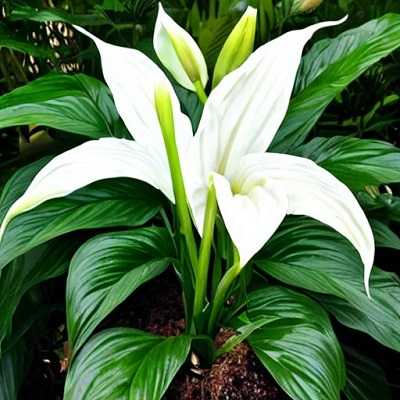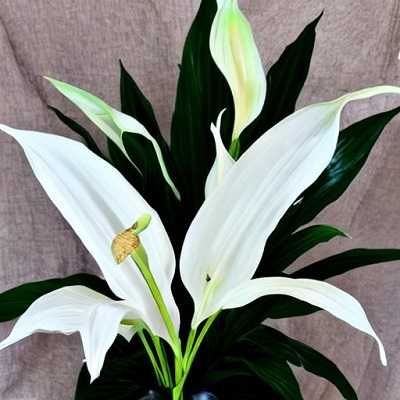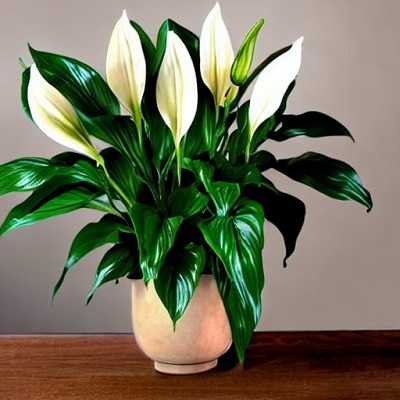The peace lily, or Spathiphyllum as it is named technically, is a prized houseplant renowned for its beautiful dark green leaves and brilliant white blossoms. A once-vibrant peace lily drooping and wilting, though, may be depressing for any plant aficionado. Reviving the plant and bringing it back to life requires an understanding of the various causes of this issue. A peace lily’s drooping may result from a number of factors, including insufficient irrigation, the environment, and insect infestations. You may successfully revive your peace lily and guarantee its ongoing health and beauty by figuring out and treating these root causes. We’ll look at 10 typical causes of peace lilies to droop in this post and provide helpful advice on how to fix it so that your Spathiphyllum may once again flourish.
Peace lily drooping
Drooping is a common problem that have an impact on the health and look of peace lilies, causing worry for plant owners. A peace lily that droops usually means that there is a problem at the root that has to be fixed. Understanding the possible effects of drooping and how to find a way to revive the plant are crucial.
A peace lily’s drooping leaves may have a variety of detrimental impacts on the plant. First and foremost, it is an obvious visible sign that something is wrong with the health of the plant as a whole. The visual attractiveness of the peace lily, which is often coveted for its rich and colorful foliage, may be negatively impacted by drooping leaves. Additionally, drooping leaves might make it more difficult for the plant to perform vital physiological functions including photosynthesis, water uptake, and nutrient absorption. This might impede the plant’s development and general health.
The peace lily drooping issue may fortunately be solved with a number of simple solutions. Since the reason for the drooping might differ from plant to plant, the first step is to identify it.

Signs of an unhealthy peace lily plant
Here are some signs of an unhealthy peace lily plant and tips on how to address them.
- Slow or no growth: If your peace lily is not growing at all or is developing extremely slowly, it may not be getting enough nutrients. Make careful to fertilize the plant in accordance with the directions and think about repotting it in new, nutrient-rich soil.
- Failure to flower: Peace lilies are well recognized for their stunning white blossoms, therefore if your plant isn’t putting forth any blooms, it may be because of a lack of light. Consider transferring the plant to a brighter area since peace lilies like strong, indirect light to survive. Additionally, watch out for overfertilizing as this might encourage the development of foliage at the price of flowering.
- Leaves that are yellowing or drooping might indicate a number of different difficulties. The most frequent cause of root rot is overwatering. Examine the soil’s moisture content and alter your watering schedule as necessary. Before watering again, let the top inch of soil to dry off. It might be a sign of nutritional shortages, such as a lack of iron or nitrogen, if the leaves are yellowing without being too damp. To remedy this, think about fertilizing the plant with a balanced fertilizer.
- Brown leaves or brown leaf tips: There are several factors that might create brown leaves or brown leaf points. Underwatering is one frequent reason. Make sure you’re giving the soil enough water to keep it regularly wet but not soggy. Low humidity levels or exposure to dry air may also lead to brown tips. By spraying the plant’s leaves or putting a tray of water nearby, you may raise the humidity level in the area.
- Aphids and mealybugs, two insect pests that may harm peace lilies, can show signs of activity. Be on the lookout for any black areas of mold that are developing on the leaves since these bugs may be a problem. Use insecticidal soap in accordance with the directions or wipe the afflicted leaves with a solution of soapy water to treat the infestation.
Possible causes of peace lily drooping
Here are some possible causes of peace lily drooping and tips on how to address them.
- Watering irregularities: Watering irregularities is one of the most frequent causes of peace lily drooping. These plants prefer constant, even moisture that is not soggy. The plant may wilt and droop if the soil becomes too dry in between waterings. However, excessive watering may result in root rot, which also causes the plant to droop. Regularly check the soil’s moisture content and make any adjustments to your watering plan. When the top inch of soil feels just a little bit dry, water the plant.
- Too much direct light: Bright, indirect light is best for peace lilies. Too much direct sunlight may stress plants and result in drooping leaves, particularly if it occurs during the warmest times of the day. Place your peace lily away from direct sunlight in an area where it gets brilliant, filtered light.
- Drafts and temperature changes: Peace lilies are delicate to both of these factors. They should be shielded from chilly winds and sharp temperature changes since they like temperatures between 65 and 80 degrees Fahrenheit (18 and 27 degrees Celsius). The leaves may droop as a result of exposure to drafts or very cold weather. Keep your peace lily in a stable, temperature-controlled environment.
- Low humidity: Tropical plants that thrive under high humidity include peace lilies. The plant may droop and its leaves may wilt if the air in your house is too dry. By utilizing a humidifier or putting a tray of water close by the plant, you may raise the humidity levels there. To provide some moisture, you may also often spritz the leaves with water.
- Overcrowding at the roots and pot size: Peace lilies love somewhat packed roots, but if they are overcrowded at the roots, it might limit their development and make the leaves droop. Consider repotting your peace lily into a little bigger container with new potting soil if you realize it has outgrown its present pot. This will give the plant’s roots more room to expand and will enable it to flourish.
- Nutritional deficiencies: Occasionally, nutritional deficits, especially a deficiency in nitrogen, may cause peace lily drooping. To ensure that the plant obtains the nutrients it needs for healthy development, make sure you are fertilizing it with a balanced fertilizer in accordance with the instructions.
- Pests and diseases: Aphids, mealybugs, and spider mite infestations may make peace lilies droop. In addition, ailments like fungal infections or root rot may cause drooping leaves. Check your plant often for any signs of insects or illnesses, such as mold, webs, or discolored leaves. If you find an infestation or illness, take the necessary precautions to treat it or, if necessary, seek expert help.
10 reasons for peace lily wilting
Wilting in peace lilies can occur due to several reasons. Below We will look at 10 common causes for peace lily wilting.
Peace lily overwatering

When a peace lily starts wilting, one of the common causes is overwatering. Brown leaf tips, yellowing or browning foliage, and a wilted, drooping look are just a few signs of stress that may result from overwatering. The plant is suffering from these symptoms because it isn’t getting the right amount of water. If the overwatering issue continues, the leaves can eventually wither and fall off. To prevent future harm to the plant, it is crucial to treat this problem.
We may consult a number of sources in order to comprehend the warning signs and solutions for overwatered peace lilies. A basic online search returns around 208,000 results in only 0.42 seconds, demonstrating the frequency of this issue and the wealth of information accessible. Following are some tips from reliable gardening sources:
- Overwatering may result in widespread yellowing of the foliage, browning of the leaf tips, generalized drooping, illnesses of the leaves, and brown, mushy roots. It’s possible for the plant to develop with stunted growth and for the leaves to lose their color and become yellow or brown. The earth may also feel damp and squishy, and the blossoms may begin drooping. It is important to act quickly to treat these symptoms, which point to an overwatered peace lily.
- How to Restore an Overwatered Peace Lily: It’s critical to change the watering schedule while dealing with an overwatered peace lily. In order to prevent waterlogging, first check that the pot has enough drainage. Remove the plant from its container and look for any signs of root rot, such as charred, mushy, or odorous roots, in the roots. Remove any broken roots and plant the peace lily again in new, drained soil. Only water the plant until the top inch of the soil feels dry, and reduce the frequency of watering. To encourage healthy development, make sure there is enough light and airflow.
- Understanding the water needs of peace lilies is crucial for taking preventative measures to prevent overwatering in the future. Although they appreciate dampness, they don’t want to be wet all the time. Root rot and other complications might result from overwatering. Only water the plant when the top few inches of soil feel dry, according to advice. Water the soil well, but make sure the extra water drains from the container. Stay away from keeping the plant in standing water as this might cause waterlogging.
- Additional Advice: You may take additional measures to preserve the health of your peace lily in addition to changing the watering schedule. Direct sunshine may burn the leaves, so give the plant some indirect, intense light. Keep the environment at a constant 65-85°F (18-29°C) temperature with a reasonable humidity level. During the growth season, fertilize the peace lily often to provide vital nutrients. To encourage new development, prune any damaged or yellowing leaves.
Underwatering a Spathiphyllum

Underwatering is one of the most prevalent causes of a Spathiphyllum wilting and drooping. The peace lily plant may get drooping and its leaf tips may turn brown if you don’t water it often and properly. To preserve the health of the plant and prevent dehydration, proper watering is necessary.
We may consult several gardening resources to comprehend the signs and solutions for underwatered peace lilies. The ubiquity of this issue and the wealth of knowledge accessible are both shown by a short internet search, which yields a wealth of material. From reliable sources, the following are some salient points:
- Underwatering may cause peace lily leaves to droop and become yellow, which is one of the symptoms. Dry soil, withered foliage, and blackened leaf tips are a few signs that the plant may be dehydrated. Usually, the lowest leaves are the ones that suffer first. The plant could seem flimsy and frail, and the soil might feel dry to the touch. These signs show that the root system is not providing the peace lily with enough water and nutrients.
- How to Resurrect an Underwatered Peace Lily: It’s critical to modify your watering schedule if you see your peace lily drooping as a result of underwatering. Fill the container to the top with water, allowing it to soak into the soil. Make sure the surplus water runs down the bottom of the container, a sign that the soil is sufficiently wet. When the top inch of soil seems dry, water the plant immediately. Regularly check the moisture levels. This helps keep the plant hydrated and avoids additional drooping.
- Establishing a regular watering schedule for your peace lily is essential in order to prevent further underwatering. These plants do well in soil that is damp but not soggy. Make sure to fully water the plant, getting the root ball as well. To prevent waterlogging, let the extra water drain out of the pot. Check the soil’s moisture content often, and water the plant as needed. Keep in mind that environmental factors like temperature and humidity may have an impact on a plant’s need for water.
- Additional Advice: You may take additional measures to preserve the health of your peace lily in addition to changing the watering schedule. Direct sunshine may burn the leaves, so give the plant some indirect, intense light. Keep the environment at a constant 65-85°F (18-29°C) temperature with a reasonable humidity level. During the growth season, fertilize the peace lily often to provide vital nutrients. To encourage new development, prune any damaged or yellowing leaves.
Too much light can cause peace lily drooping

When a peace lily (Spathiphyllum) starts drooping, one possible cause is too much light exposure. Direct sunlight may be bad for peace lilies’ leaves, which is why indirect light is preferable for them. Excessive light may cause peace lily leaves to droop and get crispy and brown, causing permanent harm to the plant.
The consequences of too much light on peace lilies are well-explained in a number of reliable gardening sites. Let’s examine a few of the major themes raised in these sources:
- Signs of Too Much Light: When exposed to too strong sunshine, peace lily leaves might dry up, become pale or bleached, and finally wilt and droop. With crispy, brown leaves, the plant may exhibit signs of stress and dehydration. It’s critical to notice these symptoms as signs of too much exposure to light.
- Peace lilies enjoy bright, indirect light as their preferred lighting conditions. It is best to put them in a well-lit room without direct sunlight or next to a window with filtered light. You can assist prevent drooping and preserve the plant’s general health by giving it the appropriate quantity of light.
- The Effect of Direct sunshine: Peace lilies are especially susceptible to the damaging effects of direct sunshine. Long durations of exposure to strong sunshine may dry out the leaves, causing wilting and drooping in the plant. It is advised to relocate the plant to an area where it gets filtered or indirect light in order to shield it from too much light.
- Finding the correct Amount of Light and Shade: A peace lily needs the correct amount of light and shade to thrive. It is crucial to keep it away from harsh, direct sunlight even though it needs enough light for photosynthesis. The plant will flourish if you give it moderate, indirect light without putting it at danger of sunburn or leaf damage.
- Preventive Measures: Think about moving your peace lily to shield it from too much light. Take the plant out of the sun’s direct rays, particularly while it’s hot outside. If required, filter the light coming into the room with sheer fabric, shades, or curtains to give the peace lily a more comfortable setting.
- Additional Care Advice: For peace lilies, it’s critical to maintain adequate watering and humidity levels in addition to limiting the light exposure. These plants like soil that is damp but not soggy. By keeping an eye on the moisture levels and periodically spraying the leaves, you can make sure the plant has enough moisture and humidity.
Cold Drafts can cause peace lilies to wilt

When it comes to peace lilies, cold drafts can be a significant cause of wilting and drooping. The ideal temperature range for these plants is between 65°F and 80°F (15°C and 30°C), with anything below 60°F (15°C) being too cold for them to tolerate. Peace lilies are sensitive to temperature changes, thus placing them close to cold breezes from fans or air conditioners might result in peace lily drooping.
Many trustworthy sources stress the effect of cold drafts on peace lilies. Here are some crucial topics covered in these sources:
- Effects of Cold: Peace lilies are sensitive to cold, and exposure to cold may make the leaves droop and wilt. Cool breezes from fans, air conditioners, or open windows may alter the plant’s ideal temperature range and cause wilting.
- Ideal Temperature Range: It’s essential to keep peace lilies between 65°F and 80°F (15°C and 30°C) in order to sustain their health. Low temperatures may shock and stress the plant, which results in wilting and drooping of the leaves.
- Avoiding Cold Drafts: Place peace lilies away from direct exposure to drafts to prevent flowers from wilting from cold drafts. Maintain a safe distance between the plants and any fans, air conditioning vents, or windows that may let in chilly air. The peace lilies will grow and flourish in an atmosphere that is steady and warm.
- Rapid temperature variations are also difficult for peace lilies to withstand. Variations in temperature between warm and cold may harm a plant’s health and induce wilting. To prevent stress and drooping, it’s crucial to maintain a constant and steady temperature for peace lilies.
- Other Care Considerations: In addition to preventing cold drafts, peace lilies need regular watering and optimal humidity levels to thrive. These plants may suffer from excessive watering but enjoy continuously wet soil. Furthermore, peace lilies need high levels of humidity, so boosting humidity by spraying the leaves or using a humidifier may help prevent drooping.
Keep in mind to pay careful attention to your peace lilies and modify your care as necessary to meet their unique demands. A local gardening professional or plant specialist may provide specialized advice for the wellbeing of your peace lilies if you see wilting or drooping despite your attempts to stop cold drafts.
Pests that can cause peace lily drooping

Peace lilies can suffer from various pests that can cause drooping and wilting of the leaves. Aphids, mealybugs, and spider mites are typical pests that may infest peace lilies and cause them to suffer. These pests may be microscopic and difficult to see, yet they may still have an impact on the plant.
Small arachnids called spider mites may seriously harm peace lilies. They are known to consume the plant’s sap, which causes the leaves to yellow and develop little spots. Spider mites may also create the thin webbing that is seen on the plant. Spider mite infestations may weaken the plant and cause drooping leaves.
Another frequent insect that may harm peace lilies are aphids. These tiny, soft-bodied insects may cause leaves to twist, deform, and finally droop as they feed on the plant’s sap. Sooty mold may develop on the leaves as a result of aphid infestations, severely endangering the health of the plant.
Mealybugs are insects that may infest peace lilies and resemble fluffy cotton buds. They often congregate in the soil and on the undersides of leaves. Mealybugs eat the plant’s sap, causing damage that might result in wilting and drooping leaves. These pests are also capable of leaving behind a substance known as honeydew, which attracts ants and encourages the development of sooty mold.
It is crucial to routinely check the plant for signs of pests and take the necessary action in order to control pest infestations and prevent peace lily drooping. You may follow the instructions listed below:
- Isolate the Plant: To prevent pest infestations from spreading to other plants, isolate the infected peace lily as soon as you see them.
- Eliminate Pests: To get rid of insects like aphids and spider mites, gently spray the leaves with water or wipe them down with a moist cloth. To treat the affected regions for mealybugs, use a cotton swab soaked in rubbing alcohol.
- Natural Solutions: You may use natural solutions to get rid of pests on peace lilies, such as neem oil or insecticidal soap. Make careful to completely cover the plant and adhere to the directions on the product’s packaging.
- Watch for Recurring Infestations and Repeat Treatment: Keep a close eye out for any signs of recurrent infestations of pests on the plant and repeat the treatment as required. To eliminate the bugs entirely, it can require many treatments.
- Maintain Plant Health: Give the peace lily the right amount of water, the right kind of lighting, and the right amount of humidity to keep it in top shape. Pests and diseases are less likely to harm healthy plants.
Inappropriate soil conditions on Spathiphyllum
Inappropriate soil conditions can often be a cause of wilting in peace lilies. The soil is essential in giving the roots of the plant the nutrients and moisture they need. When the soil conditions are unfavorable, it might have a detrimental effect on the peace lily’s health and vitality, resulting in drooping and wilting leaves. Here are some typical causes of wilting peace lilies associated with soil conditions:
- Peace lilies need continually wet soil, so avoid underwatering them. The soil may get dry if the plant does not receive enough water, causing the roots to dry up and the leaves to wilt. Drooping in peace lilies is often caused by underwatering.
- Contrarily, excessive watering may also cause wilting in peace lilies. Root rot may occur when the soil is persistently wet or has inadequate drainage, which can smother the roots. The outcome is wilting and drooping leaves because the roots can’t adequately absorb water.
- A poor watering schedule is necessary for peace lilies to grow, since they want a consistently wet but not soggy soil. Stress on the plant might occur from inconsistent watering or erratic watering schedules, which can induce wilting. In order to maintain the optimum amounts of soil moisture, it’s essential to set a suitable watering schedule.
- Inappropriate soil type: Peace lilies like drained soil that retains some moisture but doesn’t get soggy. Excessive moisture retention and insufficient oxygen circulation in the root zone might result from soil that is excessively heavy, compacted, or lacks appropriate drainage, causing the plant to wilt.
- Unsuitable soil pH: Peace lilies require a soil pH range of 5.8 to 6.5, which is slightly acidic to neutral. Nutrient deficits and wilting leaves may result from the plant’s inability to absorb nutrients if the soil pH is excessively acidic or alkaline.
- Lack of nutrition: The peace lily might become weaker and more prone to wilting in soil that is deficient in vital nutrients. For good development and foliage, adequate nutrient levels—including those of nitrogen, phosphate, and potassium—are crucial.
- When a peace lily outgrows its present container and gets rootbound, the roots may swell and become constrained. This might make it more difficult for the plant to absorb water and nutrients from the soil, which would cause wilting and drooping leaves.
Consider taking the following actions to treat wilting brought on by unsuitable soil conditions:
- Water plants properly by following a pattern and waiting until the top inch of soil has dried somewhat before watering again. Avoid waterlogging or allowing the plant remain in standing water, and be sure to thoroughly water the plant to reach the whole root zone.
- Use a potting mix that is well-draining and designed especially for indoor plants. To promote drainage, you may amend the soil mixture with perlite or coarse sand. Steer clear of dense soils that store too much moisture.
- Appropriate nutrients and pH: Check the pH of the soil and make any required adjustments using additives like dolomite lime or sulfur. To provide the peace lily with crucial nutrients, fertilize it often using a balanced houseplant fertilizer.
- Consider repotting the peace lily if it is rootbound into a little bigger container with new potting soil. To promote healthy development, before repotting, gently release the roots.
The plant needs repotting
When a peace lily is drooping, despite being well-watered, it may be a sign that it needs repotting. Repotting is required when a plant outgrows its present container or when compacted soil prevents healthy root development and water drainage. Some of the warning signs that your peace lily need repotting are as follows:
- If you find that your peace lily’s leaves are yellowing or drooping, it may be a sign that the plant is becoming root-bound and needs more room to expand. The plant may grow a healthy root system when repotted.
- Roots poking through drainage holes: This is a sure indicator that the peace lily has outgrown its present container when you see roots poking through the drainage openings at the bottom of the pot. To stretch out and properly absorb nutrients, the roots need greater space.
- Because of soil compaction, it may be challenging for water to permeate and drain efficiently in potting soil over time. Compacted soil may result in wet conditions, root rot, and generally unhealthy plants. Repotting enables the use of new, well-draining soil, fostering the development of healthier roots.
- Limited growth and a stunted look: A peace lily’s limited growth or appearance may be the result of a container that is too small for the plant. Repotting gives the plant enough area for its roots to spread out, promoting better nutrient absorption and general development.
It’s crucial to use the right procedures when repotting a peace lily in order to prevent transplant shock and guarantee a smooth transition. To avoid causing transplant shock while repotting a peace lily, follow these suggestions:
- The ideal pot size is one that is just a little bit bigger than the old one. Root rot and soggy soil might result from a container that is too big. A decent rule of thumb is to choose a pot that offers the root ball 1-2 inches of additional room.
- Make sure the new pot is ready by making sure it has drainage holes so that any extra water may flow. At the bottom of the pot, add a layer of new, well-draining potting mix.
- Before moving the peace lily to the new container, carefully loosen the plant’s root ball. This facilitates the creation of new roots and makes it easier for the roots to spread.
- Put new potting soil in the container and carefully push it down around the root ball to eliminate any air pockets. Allow room at the top so that watering may occur.
- After repotting, water the peace lily well to let the soil settle and make sure it is properly hydrated. Let the pot’s extra water drain away.
- Giving the plant the right attention involves keeping a regular watering schedule and placing the repotted peace lily in a spot with indirect light. Avoid overwatering the plant or letting it stand in water that is still.
Peace lily Root rot
When a peace lily starts drooping, one possible cause could be root rot. When a plant’s roots sustain damage from too much moisture, root rot results, which causes the rotting of the roots. To revive the peace lily, this problem must be treated immediately since it might be harmful to the plant’s general health. Here are some ways to revive a peace lily with root rot that has become droopy:
- Verify the soil’s moisture content first: Verify the soil’s moisture content. Check to check whether the soil feels damp or too saturated by inserting your finger approximately an inch into the ground. Hold off on watering the soil if it’s still wet until it starts to dry out a little.
- To improve drainage, make sure the pot has enough drainage holes that will enable any extra water to drain. To prevent waterlogging and subsequent root rot, move the peace lily to a container with drainage holes if there are none.
- Change your watering schedule to prevent overwatering in the future. While they do best in slightly wet soil, peace lilies shouldn’t spend a lot of time submerged in water. Give the plant a good watering and let any extra water run off entirely. Remove any water that has accumulated in the saucer under the plant.
- Trim affected roots: If root rot has badly damaged the peace lily, it could be essential to trim the affected roots. Examine the roots after gently removing the plant from its container. Use clean, sterile pruning shears or scissors to remove any dark, mushy, or slimy roots. you prevent the transmission of any dangerous infections, be sure you clean the equipment between cuts.
- Repot the peace lily in new, well-draining soil after clipping the troublesome roots. To enable space for fresh root development, use a pot that is just a little bit bigger than the previous one. Put excellent drainage-promoting high-quality potting soil in the container. As you place the plant in the new pot, center the root ball, and then fill the empty area with dirt. To remove air pockets from the soil around the plant, gently push down on it.
- Put the repotted peace lily in an area with bright, indirect light to provide the optimum amount of illumination. Keep the plant away from direct sunlight to prevent leaf burn. For peace lilies, a light area next to a north or east-facing window is often suitable.
- Increasing humidity may help revive a drooping plant since peace lilies like humid settings. You may either set the pot on a tray with water and stones or spritz the leaves with water often. The humidity level in the area rises as the water evaporation continues.
- After repotting, pay careful attention to how the peace lily is doing and make any necessary modifications to its care. When the top inch of soil seems dry to the touch, water the plant only then. Don’t overwater the plant or leave it in standing water.
Other Environmental Factors can cause peace lily drooping
There are various environmental factors that can cause a peace lily to droop and have drooping leaves. Other factors including temperature, humidity, lighting, soil quality, and pests may also contribute to the drooping of a peace lily, however underwatering and overwatering are the most frequent causes.
- A constant moisture level in the soil is necessary for peace lilies. Underwatering may cause the plant to get dry, which might result in drooping leaves. The opposite, overwatering, may result in root rot and drooping leaves. The top inch of soil must feel just barely dry to the touch before it is time to water the plant.
- The ideal temperature range for peace lilies is between 65 and 80 degrees Fahrenheit (18 and 27 degrees Celsius). Drooping leaves may be brought on by extreme temperatures, particularly cold drafts or abrupt temperature fluctuations. The same is true for low humidity levels, which may cause wilting and drooping. In order to maintain ideal circumstances, it may be helpful to place the plant away from drafts and increase humidity by misting or using a humidifier.
- Peace lilies require bright, indirect light, while they may survive low light levels. Direct sunshine exposure may make the plant’s leaves droop and possibly burn. On the other side, inadequate lighting might also result in drooping leaves. The optimal situation includes striking a balance and giving the plant strong yet indirect light.
- Unsuitable Soil: Peace lilies need wet, well-draining soil that doesn’t get flooded. Root suffocation and drooping leaves might result from too compacted soil or poor drainage. The ideal soil conditions may be ensured by using a premium potting mix especially designed for indoor plants.
- Pests: Pests including mealybugs, aphids, and spider mites may infest peace lilies and stress the plant, which leads to drooping leaves. Regularly checking the plant for pests and taking the right precautions, including applying insecticidal soap or neem oil, will help prevent infestations.
Other tips to keep a peace lily healthy
To keep a wilting peace lily healthy and revive it, there are several tips you can follow:
- Verify Soil Moisture: Wilting may be an indication of underwatering, therefore ascertain the soil’s moisture content. It’s time to water the plant if it feels dry to the touch. To prevent overwatering, which may cause root rot, make sure the container has sufficient drainage.
- The proper way to water is to completely saturate the potting mix and water should eventually flow out of the drainage holes. To prevent waterlogging, discard any extra water that gathers in the saucer. Striking a balance is crucial in order to prevent both underwatering and overwatering.
- Placing the peace lily in indirect bright light is best since direct sunlight might burn the leaves. Its development and vitality are best served by indirect strong light. Positioning the plant in a room with an east or north window is a smart idea.
- Increase Humidity: Tropical plants like high humidity, such as peace lilies, benefit from it. Regularly misting the leaves with water might help raise the humidity level surrounding the plant. To create a humid microclimate, you may also lay a tray below the pot that is filled with water and stones.
- Dusting Leaves: Dust that builds up on leaves may prevent a plant from photosynthesizing. To maintain the leaves clean and promote improved airflow, gently wash the tops and bottoms of each leaf with a soft, moist cloth.
- Increase Nutrition: The potting mix for peace lilies may lose nutrients over time. During the growth season (spring and summer), you may apply a balanced liquid fertilizer once a month, diluting it to half strength to ensure the plant obtains appropriate nourishment.
- The ideal temperature range for peace lilies is between 65 and 80 degrees Fahrenheit (18 and 27 degrees Celsius). Avoid placing the plant in hot, dry air or cold breezes since these extremes might stress the plant and induce wilting. The plant’s health depends on maintaining a consistent temperature range.
- Address Pest Problems: Keep an eye out for common pests like aphids, mealybugs, and spider mites on the peace lily. Use the right pest management techniques, such as neem oil or insecticidal soap, to get rid of the infestations and prevent additional harm.
Drooping Peace Lily Plants – The Final Word
In conclusion, drooping peace lily plants may be brought on by a number of factors, such as inadequate watering, problems with light and temperature, low humidity, unfavorable soil conditions, and insect infestations. You may revive a drooping peace lily and guarantee its long-term health and beauty by taking care of these factors and giving it the appropriate care, such as appropriate watering, adequate lighting conditions, improved humidity, and routine maintenance. Your peace lily will repay you with lush foliage and eye-catching blossoms, providing a sense of tranquility to your interior area, if you are patient and pay close attention to every aspect.
Related Posts:
Are Peace Lilies Toxic To Cats?
Peace Lily Spiritual Meaning: Symbol, Feng Shui, Benefits (uk)
Are Peace Lilies Toxic To Dogs?
What Is the Meaning Behind White Calla Lily Flowers (Occasions To Send Them)
